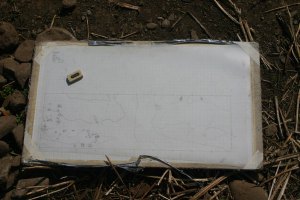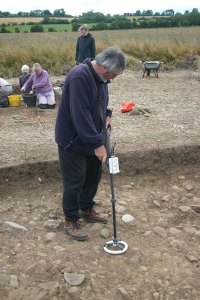Day 13 – Putting our best foot forward.
Work continued from yesterday with Eimear planning in Area 1 (Cutting 6), Matt excavating features in Area 2 (Cutting 7), Niamh extending the cutting to expose the full extent of the grave cut, and the rest of the team taking down the rest of the base of ploughsoil material in Cutting 8. Kevin, our geophysical surveyor, was also on site again to monitor progress, compare the excavated features to the anomalies identified in the initial surveys and take some additional readings.
.
.
.
.
.
.
.
.
In Area 1, Cutting 6, Eimear’s plan is nearing completion. The process is taking some time because of the size of the cutting and the complexity of the features and soils there. However, she is nearly finished and we will be taking levels on the surface tomorrow morning and assigning numbers to each of the separate fills and features. We even made a start this afternoon on one spread of material that seems to be occupation/refuse spread associated with the occupation of the oval enclosure. This appears to overlie the lower north-south ditch fill so we set Igor up to put a section across it to assess its depth. By tomorrow we will hopefully know what its exact relationship is to the other features and fills around it.
Matt continued to deal with other features in Cutting 7 while Niamh and Sarah excavated the 1m x 0.5m extension to the cutting to fully open up the grave cut. His feature today, numbered F.705, appeared on the surface as a spread of charcoal flecked soil extending over an area c.1m in extent and disappearing beneath the northern baulk. As Matt excavated the feature revealed itself to be small furnace with a number of heat-shattered stones around and in it. The fill is mainly charcoal-rich soil, which we sampled. There was also a stone with a distinct concretion suggestive of some sort of slag, waste material from an industrial process, possibly metalworking. The base of the feature was reddened, baked soil, indicating intense heat. The proximity of this feature to the grave is interesting as it is not unusual to have such industrial features close to burials on non-ecclesiastical sites. Niamh, Sarah and Ciara gradually removed all of the ploughsoil from the extension and revealed the line of the grave cut retrieving a fragment of cranium from the ploughsoil Matt then added this detail to the previously drawn plan and proceeded to tidy up the area and continue to excavate it.
.
.
.
.
.
.
.
In Cutting 8 the team there continued to remove, using trowels, the base of ploughsoil/interface layer. At the southern end of the cutting Igor had recovered a number of pieces of human bone and a tooth which indicates that there were probably other graves in that area which are now destroyed by ploughing. There is also a small gully-like feature here which appears to be relatively late in date and may be associated with later agricultural activity. Also at the southern end of the cutting, Lisa found her first feature. It looks at this stage like a very nice post-hole – an area of loose darker soil surrounded by a ring of packing stones. We will take a closer look at it in due course.
Kevin was on hand again to look at how work was progressing. He took additional magnetic susceptibility readings from the excavated surfaces of each of the cuttings and recorded interesting results. The values were all significantly higher than those recorded at the surface prior to excavation. There will be a very useful dataset gathered by the end of the excavation to carry out detailed comparisons between pre-excavation surface readings and post excavation readings as well as surface soil samples and ‘top of archaeology’ soil samples. Kevin also took the opportunity to scan the spoil heaps with a metal detector to ensure that we hadn’t missed anything (I don’t think we have but you never know..!) and he also scanned the unexcavated surfaces around the cuttings. In the afternoon, Kevin used a total station to survey in some of the major features identified on the site so far like the grave cut and the edges of the ditches in Area 1 Cutting 6.
In the afternoon we had a bit of diversion when the group of students currently working a the Blackfriary site in Trim paid us a visit. They are part of the Irish Archaeological Field School and on their way they visited the Bective site. I think the students enjoyed their visit and they told us that it was quite different to the other two sites.








